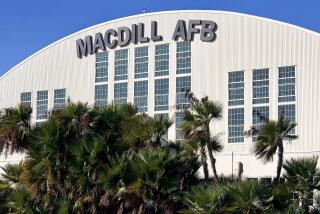Base Folds Wings After 85 Years
- Share via
SAN ANTONIO — It was just a little Spanish phrase, followed by a slug of beer, born on some forgotten day in the icehouses and taquerias on the western edge of town.
Que no se acabe Kelly. Roughly, it expresses the hope “that Kelly never goes away.” For years the words were a mantra for prosperity in these intimate, scrappy neighborhoods, a superstition akin to tapping wood or clutching a rabbit’s paw.
In fact, nobody thought Kelly Air Force Base was going anywhere. The vast, gated compound was an institution. It was bread and a roof and tuition money for thousands of families. It gave birth to a Latino middle class in this old Texas city.
But the 85-year-old aviation base is no more. In a sticky Friday afternoon ceremony, in a flurry of speeches and flyovers and salutes, the American flag was hauled down one last time. It was the somber end to six painful years: Kelly was ordered closed in 1995 and has been folding up and shutting down ever since.
“It’s tough, to say the least. Kelly was everybody’s provider in the community,” said Janie Mora, 57, sipping coffee in her airy Mexican eatery. She and her husband opened Salsa Mora’s with savings tucked aside during Frank’s three decades as a machinist at the base.
“We were loyal to the military, very patriotic. So when they said, ‘We’re going to close what puts food on the table,’ it felt like a betrayal,” she said.
Mora was 3 years old when her mother died. An uncle took her in and raised her on wages from his job at the air base. Later, when Mora fell in love, walked out of high school, got married and had the first of seven babies, she stretched Frank’s paychecks from Kelly into a thrifty household budget.
And so it went in hundreds of bright, cramped westside homes: The base eroded cycles of menial labor and scant educational access. Mora’s children studied in college. She and Frank bought a house. Politicians, professors and lawyers trek to Salsa Mora’s for pungent platters of mole and enchiladas.
“Kelly made it possible to have a middle-class life,” said former Mayor Henry G. Cisneros. “In household after household, children were able to enjoy a path to college because of that good, solid wage.”
Just as Midwestern blacks found stability in the automotive plants of Detroit, Cisneros argues, San Antonio’s Latinos flourished because Kelly Air Force Base provided blue-collar jobs, relatively high wages and government benefits. Families found a foothold, slowly and painstakingly. Generations scraped prosperity from graveyard shifts, paychecks and night classes.
For much of the 20th century, the Air Force compound was San Antonio’s biggest employer. At times, its payrolls included more Latinos than any other workplace in the nation. In 1995, nearly half the Latinos employed by the Air Force were at Kelly.
It is an ugly scab of land: 4,600 acres of cement and scrubby grass under a yawning Texas sky. But from the west side of town it was a heady vision: the bustle and roar of people and machines; the concrete and steel incarnation of industry, progress and motion.
It was romantic, exhilarating: Generations of kids parked their first cars as close as they could get to the airstrip to watch the great metal birds tremble off into the heavens.
Kelly represented vacations and immunizations. It was a tidy retirement plan beckoning after decades of toil. It was a payday treat: a Technicolor movie, dinner in a restaurant, a ride on the roller coaster at the old Playland Park.
“It was getting up and going to work, it was the smell of coffee and bacon, making tacos for your husband to take,” Mora said. She spread her fingers and shrugged. “It was life. It meant everything.”
But now the base is a sea of empty parking lots, barren cement walls and cavernous, desolate buildings.
“There used to be so many people here. You couldn’t even find a parking space,” said Irma Blancas, driving her Chevy through the guarded gate onto the scorched, silent streets of the air base on a recent afternoon. “All these buildings were full.”
Her cellular phone rang.
“Hello? . . . No, we’re not part of that. . . . No, we’re not. . . . No. . . . Thank you.”
She hung up.
“People are looking for jobs,” she said. “What can you do? We had somebody walk in this morning. I tell them, ‘We’re not hiring.’ ”
Kelly jobs always surged and ebbed as America passed through periods of war and peace. It was the dark times--world wars, the Cold War--that spilled prosperity into town.
At its peak, in 1917, 39,000 civilian and military workers drew Kelly salaries. In 1995, when Kelly’s death knell sounded, there were 17,000 jobs on the base.
Blancas was among them--and when word of the closure spread, the 35-year-old software programmer moved fast. She used her decade of training to open a computer networking firm in an old Air Force morgue on the base.
The establishment of tiny Pathway Enterprises Inc. was a proud coup for the Blancas family--Irma’s parents never earned high school diplomas. They were migrants and the children of migrants, a couple that chased the harvests up and down Interstate 35, picking and planting their youth away in the hot fields from Texas to Michigan.
“Kelly meant that you made enough that you didn’t have to go down to work in the fields,” Blancas said.
It’s no wonder that news of the base closure was such a blow to this neighborhood. Catholic congregations murmured prayers for Kelly’s redemption. Distraught families drew up signs and stickers: “Viva Kelly!” “Keep Kelly open,” begged T-shirts.
In the last six years of layoffs and transfers, families have been divided. Men and women followed their jobs to other military facilities in Georgia, Oklahoma, Utah and New Mexico to work out their retirement--a tough exile for families rooted in these tight, ramshackle neighborhoods.
A city agency is rushing to convert the base into a distribution park. Some 37 companies have already set up shop, but there’s a long way to go: The site now has fewer than 4,000 jobs--not even a quarter of the city’s goal of 21,000. The facility is old, and environmental cleanup could take decades.
Still, Kelly did its job. It sprinkled the old American dream over the westside, gave families education and hope--things that can’t be erased or snatched back.
San Antonio Mayor Ed Garza told military and civic leaders at Friday’s ceremony that his grandfather worked at Kelly; his father was the first in the family to go to college.
“I stand here with personal gratitude,” Garza said. “Today is a bittersweet day.”
More to Read
Sign up for Essential California
The most important California stories and recommendations in your inbox every morning.
You may occasionally receive promotional content from the Los Angeles Times.













